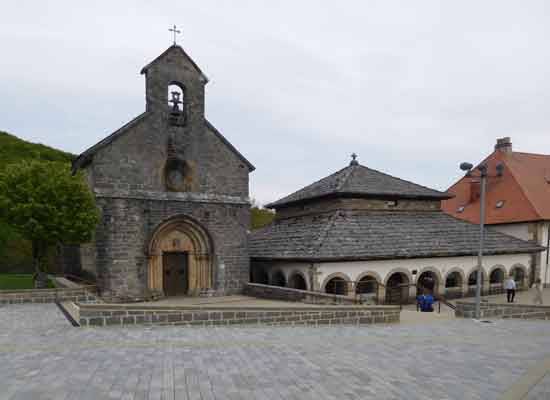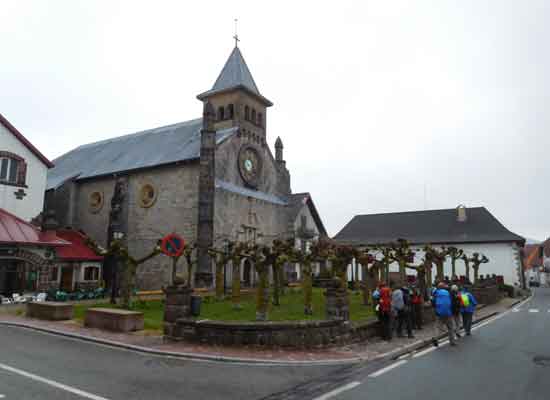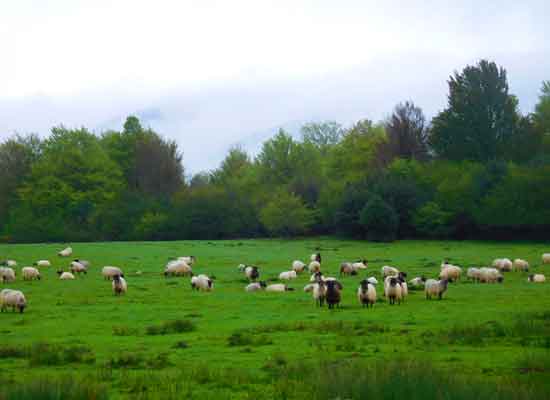Step by Step on The Way of Saint James
From Roncesvalles to Zubiri
12 May 2018
Stage 2 – 21 km

Yesterday afternoon, after a shower and a short rest, the muscles in my lower limbs were tight, stiff, and sore, saturated with lactic acid.
Even though this was a “normal” condition caused by prolonged exertion of feet and legs, I asked myself: – How will I be able to set off again tomorrow and face another day of walking, if I can barely take a few steps now? –
Yet, after a night’s sleep, as if by magic, my feet and legs were back in good condition and ready to set off again.
The difficulty in walking during the afternoon, after completing a stage, will almost be a daily occurrence; however, every morning everything will be back to normal, and I will be able to tackle the many kilometres ahead.
In reality, as is universally recommended after physical activity, instead of stopping immediately, it would be better to spend at least ten minutes doing stretching exercises while the muscles are still warm.
This is a practice I neglect – wrongly! – since every time I reach my destination, all I can think about is getting into the shower.
This morning I set off at 7:00, accompanied by Franco, Peppe, and our new friend Maria.
As I have already mentioned, walking is an activity that should be done at one’s own pace, without speeding up or slowing down to match someone else.
Therefore, starting off together doesn’t necessarily mean walking the entire stage side by side. It’s normal to move ahead, fall behind, get separated, and then reunite.
If, by the end of the day, we stop in the same location, it will be easy to meet up again and perhaps spend the evening together.
One of the wonderful things about The Way of Saint James is that you can spend a lot of time alone with your thoughts, but you can also interact with people from all over the world: from Tierra del Fuego to Australia, from South Africa to Canada, from Korea to Argentina.
You walk and chat for a while in Spanish or Italian with a Colombian and then shortly after, speak to a Japanese person using English and a lot of gestures.
Only with the French, who stick to speaking their own language, was I unable to communicate much, as I have no knowledge of French.
Despite this, I still managed to establish friendly relationships with many of them thanks to the universal language of a smile :-)
Of all the French people I met, my thoughts go particularly to Anna, a wonderful woman in her seventies, walking The Way alone: independent, well-organised, and with a brisk and determined pace.
She also stood out because, along with her strictly trekking attire, she always wore a thick gold necklace and matching pendants.
The first time I saw Anna was when I helped her straighten her backpack, which she was unknowingly carrying unevenly.
From that moment on, every meeting was a little celebration: although we couldn’t understand each other due to my lack of French, a simple – Bonjour! – and a smile were enough to solidify our friendship.
***
This morning, unlike yesterday, the weather is not favourable.
After the beautiful sunny day that accompanied me through the Pyrenean stage, today the sky is grey, and although it’s not raining yet, I don’t think it will take long to start.
To avoid delays, we leave the hostel without breakfast, promising to stop at the first village we come across.

On arriving at the entrance to Burguete, we skip the first café we see, thinking there will be others in the village centre.
However, as we continue, we find everything closed, and unwilling to turn back, we keep walking on empty stomachs.
As I pass by an ATM, I decide to withdraw some cash to test whether my card actually works abroad. I pull it out of my wallet and, to my dismay, discover it’s broken cleanly in two. Fortunately, the chip is still intact.
I have no idea how it happened, but this is the situation, and I’ll need to find a solution soon, as my entire financial plan for The Way depends on this card.
I have enough cash to last a few days, so for now, I put the problem aside and hope to reach a larger town or city to sort it out.
***
Today’s stage can still be considered within the Pyrenean area.
The route is not particularly difficult: gentle climbs and descents alternate, and when we arrive in Zubiri, we will be just over four hundred metres lower than Roncesvalles.
The landscape is distinctly pastoral, with green fields where sheep, cattle, and even horses with thick, long manes graze.
The areas of Alto de Mezkiritz and Alto de Erro are especially beautiful, as the route passes through dense forests; after these, we won’t encounter any more until we reach Galicia.
– I shouldn’t have skipped that first café this morning, as I didn’t find any others further along the way. –

It’s just before 10:00 when I pass through Bizkarreta-Gerendiain, the third village I encounter today.
I’m roughly halfway through the stage and – finally! – find a place open for a proper breakfast.
My arrival coincides with the first drops of rain, which quickly turn into a heavy downpour.
Inside the bar, I set down my backpack and, before joining other pilgrims at a table, grab a tortilla and a glass of freshly squeezed orange juice.
The “tortilla de patatas” is simply an omelette made with eggs and large chunks of potato. Thick and compact, it’s served with a slice of bread.
It’s one of the staples of Spanish cuisine and can be found in any café or restaurant.
For walkers, it’s an excellent source of energy, and like other pilgrims, I often enjoy it during breaks.

After finishing my break, it’s still raining, so it’s the perfect time to put on my brand-new poncho, which I bought specifically for The Way. However, I decide to wait a bit longer before trying out the gaiters, also purchased for this journey, as the rain isn’t too heavy yet.
At 13:10, I arrive in Zubiri.
I cross the so-called “Bridge of Rabies” and, just a few metres further, reach the Albergue Zaldiko, where, luckily, I manage to get the last available bed.
I felt sorry for the pilgrim who arrived at the hostel just after me and was turned away due to a lack of space. The rule here is – First come, first served! – and if there’s no room, you either try another place or head to the next village.
That’s exactly what happened to some Italian pilgrims who, upon reaching Zubiri, found no available accommodation anywhere and had no choice but to take a taxi to the next village.
– Oh dear! True pilgrims walk—they don’t take taxis. –
The temporary lack of beds is partly due to a youth gathering taking place at the municipal hostel here in Zubiri.
I have no news of my Neapolitan friends, Peppe and Franco, nor of Maria. We set off together this morning from the hostel in Roncesvalles, but after a few kilometres, we lost sight of each other.

In the afternoon, I take a stroll around Zubiri.
The village is tiny, and there’s not much to see.
The Gothic bridge over the Arga River is particularly charming; it’s called the “Bridge of Rabies” because, according to local beliefs, both animals and people could be cured of the disease—or even prevent it—by circling the central pillar several times.
While wandering through the village, Peppe calls me to say that he and the others are also in Zubiri and have found a small apartment to stay in.
He mentions that their accommodation has a kitchen and suggests we do some shopping and prepare dinner at home.
I’m immediately appointed “chef,” simply because I’m the only one in the group with a bit of cooking experience.
I’m not entirely convinced by the idea, but since there isn’t much else to do in Zubiri, it could be a way to spend the evening. Besides, the weather is chilly and drizzly.
So, as I’m already out and about, and the others are still busy with showers and laundry, I go shopping on my own, picking up whatever inspires me.
In these situations, a classic choice is pasta with tuna, followed by some cold cuts and cheeses. The highlight of the dinner will be a bottle of Rioja wine, which I pay around twenty euros for, hoping that the price guarantees quality.
Once the shopping is done, I head to my friends’ apartment and make myself comfortable in the kitchen.
Since it’s still a bit early to start cooking, we nibble on some leftovers from lunch.
Also joining us is Eloise, a French girl who speaks reasonably good Italian.
I crossed paths with her yesterday on The Way and, seeing her looking a little lost, I asked if everything was okay.
– Yes, everything’s fine, thanks. I’m just walking slowly. – That was her reply, accompanied by a grateful smile for my concern.
We invite Eloise to join us for dinner as well.
Time passes pleasantly with conversations and snacks, until—after more than an hour spent in the living room—we realise that the kitchen has no stove.
I ask the landlady about it, and she tells me we can cook the pasta using the microwave.
– That’s right! She said mi-cro-wa-ve. –
Naturally, as good Italians, we are horrified at the thought of preparing our culinary staple this way.
But since we have no other choice, we let her explain the process:
1. Heat some water in the kettle for tea; 2. Put the uncooked pasta in a bowl and pour the hot water over it; 3. Place the bowl in the microwave and set it to maximum power; 4. Cook for ten minutes, stirring every two minutes.
Before starting on the pasta, I prepare the sauce by mixing canned tomatoes and tuna in a bowl, cooking it in the microwave for several minutes, stirring occasionally.
I have to say, I wasn’t particularly impressed with the result, but the others seemed to enjoy it—they even went back for seconds and thirds.
– It’s true what they say—when you’re hungry, you’ll eat anything! –
| © Aldo Lardizzone 2020 |  |
CREATIVE COMMONS |



